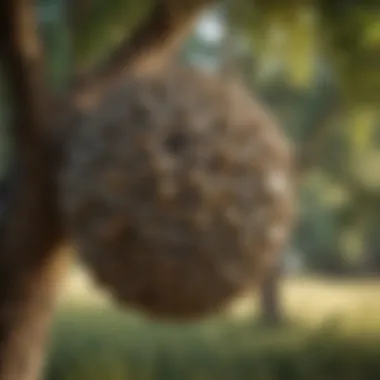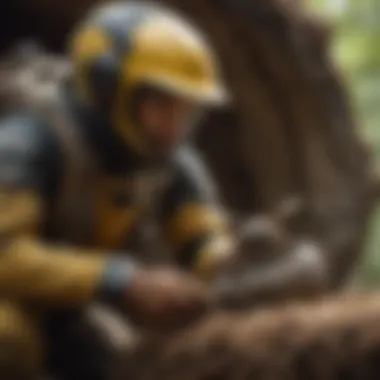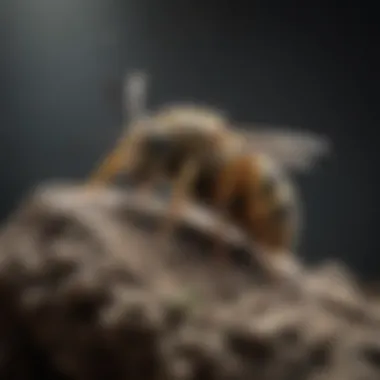Effective Strategies for Removing a Large Wasp Nest


Intro
Understanding how to manage a wasp nest, especially one that is considerably large, is essential for maintaining safety and preventing further infestations. This task comes with its own set of challenges, and awareness of the behavior of these insects can make the process smoother and less risky. Wasps can be aggressive, and their presence may create anxiety for many homeowners. The complexities of wasp behavior and nest construction necessitate a careful approach, which this guide aims to address comprehensively.
Animal Profile
General Overview
Wasps are part of the order Hymenoptera and the family Vespidae. This group includes various species that exhibit diverse behaviors and nesting habits. Unlike bees, wasps have slim bodies and tend to be much more aggressive when defending their nests. Common species include the yellow jacket and the paper wasp, each with distinct traits and nesting preferences.
Habitat and Distribution
Wasp nests can be found globally, commonly in urban areas and rural environments. They often choose sheltered locations such as the eaves of buildings, attics, and trees. Understanding where these nests form helps in preventing future infestations. In typical habitats, the nests are built using a paper-like substance created from chewed wood fibers mixed with saliva, which adds to the structural integrity of the nest.
Fascinating Facts
Unique Traits and Adaptations
Wasps possess a variety of adaptations that enable them to thrive in diverse environments. Their ability to hunt for food, such as other insects, helps maintain ecological balance. Notably, many wasps are solitary, while others form complex social colonies. This dynamic influences their nesting patterns and aggressiveness towards perceived threats.
Historical and Cultural Significance
In various cultures, wasps symbolize diligence and community, given their social structures. Historically, they have been studied for their role in ecosystems as pollinators and pest controllers. However, many view them primarily as nuisances, which further denigrates their importance in natural pest management.
Conservation Status
Current Population Trends
Wasp populations, like many insect species, face challenges from habitat destruction and climate change. Some species have seen a decline, while others remain stable. Monitoring these changes is crucial for maintaining ecological health, as they play significant roles in controlling pest populations.
Threats and Challenges
Key threats to wasp populations include pesticide use, loss of biodiversity, and environmental disruption. Awareness of these factors is essential not only for conservation efforts but also for understanding wasps’ roles in our surrounding environments.
Care Tips for Pet Owners
Basic Needs and Requirements
If pets are present in areas where wasps are common, it is vital to take precautions. Keeping pets supervised outdoors and maintaining a wasp-free zone is recommended. Following proper waste disposal practices also reduces the attraction for wasps.
Health and Wellness Tips
Monitor pets for signs of stings and allergic reactions. First aid should be readily available, and consultation with a veterinarian is advised if reactions occur. Ensuring a safe environment for pets contributes to managing wasp encounters effectively.
Tip: Consider natural deterrents such as planting certain flowers that repel wasps, thus reducing nest formation.
Navigating the complexities of wasp nest removal starts with understanding their behavior and ecology. Being informed not only enhances safety but also aids in effective management strategies.
Understanding Wasps
Understanding wasps is crucial for anyone facing the challenge of a nest, especially a large one. Knowledge about their nature and behavior can greatly influence the approach one takes to remove a nest safely and effectively. This section of the article aims to shed light on critical aspects related to wasps, which include their behaviors, ecological roles, and various types that may inhabit residential spaces.
Nature and Behavior of Wasps
Wasps are social insects that belong to the order Hymenoptera. They play essential roles in ecosystems as pollinators and as predators of other pests. Their social structure usually involves a queen, workers, and drones, depending on the season. Most wasps are known for their aggressive defense of their nests. They can sting multiple times, which is a significant risk when dealing with larger nests. Understanding this behavior is crucial for both prevention and removal strategies.
Wasps often build nests in secluded areas, such as under eaves, inside walls, or in trees. They typically prefer locations that are sheltered but accessible. The nests are constructed from chewed wood fiber mixed with saliva, creating a paper-like material. The lifecycle of wasps has several stages, including egg, larva, pupa, and adult. During their active season, from spring to fall, their populations can grow exponentially.
Common Types of Wasps


Several species of wasps are commonly found in various regions. Recognizing these species can help individuals take appropriate action when dealing with a nest. Here are some common types:
- Yellow Jackets: These are known for their aggressive nature and black-and-yellow coloration. They often invade food sources, making them a nuisance during outdoor activities.
- Bald-faced Hornets: Recognized by their white face and black body, they build large, aerial nests. They are quite defensive and can sting multiple times.
- Paper Wasps: These have a more elongated body and are less aggressive than yellow jackets or hornets. They prefer to build their nests in open areas, often under eaves or on tree branches.
- Mud Daubers: Unlike other wasps, mud daubers are solitary and build nests using mud. They are less of a threat to humans and are often beneficial as they control spider populations.
Having this understanding about their nature and types will prepare individuals to respond wisely. This is especially important when assessing the size and location of the nest, which influences safety measures and removal tactics.
Knowledge about wasp behavior can help you avoid unnecessary risks when removing a nest.
Identifying Wasp Nests
Identifying wasp nests is a critical step in managing these pests. Recognizing the nest can help in formulating effective removal strategies. Large wasp nests can pose significant threats, not just due to their size but also because of the potential aggression of the wasps inside. Understanding the nest's characteristics and signs of wasp infestation reduces risks associated with removal attempts and aids in planning. Here, we will delve into the specific features of large wasp nests and common indicators of an infestation.
Features of a Large Wasp Nest
A large wasp nest has distinct features. Generally, it is made from a paper-like material created by wasps chewing wood fibers mixed with their saliva. This construction gives the nest a greyish appearance. You will often recognize these nests hanging from trees, under eaves, or in sheltered areas.
Key characteristics include:
- Size: A large nest can be the size of a basketball or even greater, often measuring over 12 inches in diameter.
- Shape: Most large wasp nests have a round or oval shape, appearing layered or organized in sections.
- Entry Holes: Look for multiple small entry and exit holes. These are used by the wasps to come and go frequently, indicating an active nest.
An efficient way to identify nests is to observe wasp activity, particularly during the day, as these insects are primarily daytime foragers.
Signs of Wasp Infestation
Detecting a wasp infestation can sometimes be straightforward, though it requires attention to detail. Here are common signs that indicate a possible infestation:
- Wasp Sightings: If you frequently see wasps flying around your property, especially near certain areas, this may signal a nearby nest.
- Nesting Material: Finding chewed wood pulp or paper-like material around your property may indicate wasps are constructing nests.
- Aggressive Behavior: If wasps become aggressive when you approach an area, it suggests that you are near their nesting site.
- Increased Activity in Late Summer: Wasp activity often increases as the season progresses. Be particularly vigilant in late summer and early autumn when nests are at their largest.
Properly identifying the signs of a wasp infestation enhances your ability to manage and remove wasps safely and effectively.
Identification is essential before any control measures are taken. Recognizing nests and signs early can prevent more significant issues later on, including potential stings or infestations that are more difficult to manage.
Assessing Risks and Concerns
Understanding the potential risks when dealing with a large wasp nest is crucial. Wasps can be aggressive when they feel threatened. Their instinct is to protect their nest, which can lead to dangerous situations. Therefore, accurately assessing these risks plays a vital role in planning for safe removal.
Potential Dangers of Large Nests
Large nests indicate a significant wasp population. This can increase the likelihood of aggressive behavior, especially when the nest is disturbed. A few aspects are important to consider:
- Aggression: Wasps may become hostile if someone approaches their nest. This behavior varies by species, but even normally docile wasps can act aggressively when their home is threatened.
- Swarming: If disturbed, wasps often swarm. This reaction can lead to multiple stings in a short period, increasing the risk of serious injury or distress.
- Structural Risks: Over time, large nests can cause physical damage to the structure they inhabit. This is especially true for nests located in attics or walls.
Beware that wasps are not the only insects that might inhabit a nest location. Sometimes, they coexist with other species, which could also pose risks during removal.
Allergic Reactions and Safety Precautions
The probability of someone's allergic reaction to a wasp sting is a crucial factor when dealing with nests. Many individuals are unaware of their allergy status until an incident occurs. Taking precautions is essential for safety.
- Know Your Health Background: It's important to know if anyone in the vicinity has a history of allergic reactions to stings. If so, prepare thoroughly.
- Wear Protective Clothing: Use long sleeves, pants, gloves, and even a face shield when approaching a nest. This can help minimize sting risk.
- Have an Action Plan: In case of an allergic reaction, having an epinephrine auto-injector on hand can be lifesaving. Ensure someone nearby knows how to use it.
- Inform Others: Inform anyone nearby of the activity. Keeping bystanders at a safe distance will minimize their risk and stress.
Tip: Assess the environment before initiating any removal attempts. Ensure the area is clear of unnecessary personnel to avoid panic and confusion.
Overall, assessing risks and taking precautions is a determining factor for successful wasp nest management. Ignoring such aspects may lead to injury or escalated conflicts with wasps.
Preparation for Removal
Preparing for the removal of a large wasp nest is a critical phase in ensuring a safe and effective outcome. It involves understanding the risks associated with the task and ensuring that all necessary steps are taken to minimize danger. This preparation can significantly decrease the likelihood of being stung and ensures that the process is efficient.
Assessing Your Environment
Before proceeding with removal, it is essential to analyze the environment surrounding the wasp nest. Factors such as the nest's location, proximity to human activity, and weather conditions play a vital role in this assessment.


First, identify the physical location of the nest. Is it situated within reach of children or pets? Is it close to frequently used areas like patios or gardens? These considerations are critical. If the nest is in a remote area, removal may be less urgent than one that threatens human safety.
Next, consider the weather. Rain, wind, or cold temperatures can affect wasp behavior. Wasps are generally less active during cooler weather, making it a preferable time for removal. Conversely, during warm, sunny days, they may be more aggressive.
Furthermore, take note of the time of day. Wasps are more likely to be inactive during early morning or late evening. Planning the removal during these times can increase safety.
"Safety should always be the primary concern when dealing with wasp nests. Understanding environmental factors is key to this process."
Gathering Required Equipment
Gathering the appropriate equipment is another essential step in preparation. Using the right tools can facilitate effective removal while ensuring personal safety.
Start by equipping yourself with protective clothing. Long sleeves, pants, gloves, and a hat can provide essential barriers against stings. A bee veil can also be beneficial if you are dealing with particularly aggressive wasps.
Next, consider the tools needed for removal. Depending on your chosen method, this may include:
- Insecticidal spray designed specifically for wasps
- A dust applicator for specific treatments
- A long pole or stick to reach high nests
- A sturdy garbage bag or container for nest disposal
Also, a flashlight can be valuable, especially if extra light is needed for late evening or early morning removals. Have all these items ready and easily accessible to avoid interruptions during the removal process.
Taking time to prepare your environment and gather the right equipment greatly increases the likelihood of a safe and effective removal of a wasp nest.
Effective Removal Techniques
Removing a large wasp nest effectively requires a clear understanding of the methods available. Each method has its own advantages and considerations. Proper removal techniques not only ensure safety but also minimize the likelihood of further infestations. Selecting the right approach can prevent damaging encounters with wasps, especially considering their aggressive nature when threatened.
Chemical Methods
Chemical methods for wasp removal often involve the use of insecticides specifically designed to eliminate these pests. Products such as Raid Wasp and Hornet Killer are popular choices. These sprays provide a targeted approach, allowing users to direct the application precisely at the nest. Here are key points to consider:
- Timing: Nighttime is ideal for application as wasps are less active then.
- Distance: Maintain a safe distance; most sprays can reach up to twenty feet.
- Proper Equipment: Use protective clothing to guard against possible stings. Gloves, masks, and long sleeves are recommended.
Chemical methods are effective but require caution. The chemical may not only impact wasps but also the surrounding environment. Always consider eco-friendly options when possible.
Physical Removal Techniques
Physical removal techniques necessitate a more hands-on approach to wasp nest elimination. This method typically involves using tools to dismantle or destroy the nest. Here are the important aspects:
- Tools Needed: Items like long-handled vacuums or dusters can be used. A shovel may also be necessary for larger nests.
- Timing is Key: Similar to chemical removal, it is best to approach the nest at night when wasps are in a dormant state.
- Complete Removal: If you decide to take down the nest physically, ensure you collect all fragments to prevent a new colony from forming.
Physical removal provides a direct solution but poses a higher risk. Ensure you are prepared for unexpected wasp activity.
Natural Remedies for Wasp Control
Natural remedies offer alternative methods to control wasps, appealing to those who are concerned about chemical usage. These solutions typically rely on non-toxic ingredients and methods. Common options include:
- Peppermint Oil: Combining peppermint oil with water can create a natural spray to deter wasps. The strong scent disrupts their navigation abilities.
- Traps: Homemade traps can be effective. A mixture of sugar water and vinegar in a bottle can attract and trap wasps successfully.
- Decoy Nests: Hanging a decoy nest may discourage wasps from building nearby. Wasps are territorial and often avoid areas where they think other colonies exist.
Natural remedies are often less harmful to the environment but may take longer to see results. Utilizing these methods can contribute to a holistic approach to pest management.
Important: Assess your surrounding before choosing a removal strategy. Safety remains paramount while dealing with wasps.
Post-Removal Care
Post-removal care is a critical phase following the elimination of a large wasp nest. Ensuring the area remains safe and free from future infestations is paramount. This section details the necessary steps for monitoring and repairing any damage left behind.
Monitoring for Reoccurrence
After removing a wasp nest, vigilance is essential. Monitoring for signs of a return is imperative to avoid re-infestation. Observe the area regularly for any new wasp activity. Wasps may attempt to rebuild or establish new nests nearby if the conditions are favorable. Some effective monitoring tips include:


- Check for new nest structures around the area where the previous nest was located.
- Pay attention to increased wasp activity during the warmer months, particularly late summer and early fall, as wasps are more active and inclined to build nests.
- Use a watchful eye on potential nesting sites such as eaves, porches, and trees in close proximity to the initial removal site.
Implementing these practices provides an early warning system, allowing for timely intervention should new nests form. If you notice signs of a returning population, it may warrant additional action, whether through targeted removal methods or more professional pest control assistance.
Repairing Damage Left Behind
Wasp nests can cause various types of physical damage to structures. Whether it's an exterior wall, roof, or even a tree, addressing any damage is crucial for restoring the area. Repairing any holes or structural issues mitigates the risk of future infestations. Steps to consider include:
- Assess the area: Identify the extent of the damage. Some nests can leave significant marks or holes, while others may cause minimal disruption.
- Seal openings: Use caulk or suitable fillers to close any gaps or holes. This reduces the chances for pests to enter.
- Clean the area: Remove leftover nest debris thoroughly. Leftover materials may attract other pests or show signs of prior infestation.
- Evaluate surroundings: Consider trimming back branches or shrubs that may provide easy access for wasps or other pests.
Repairing any damage ensures both safety and comfort, preventing further pest-related concerns.
By maintaining careful attention during the post-removal phase, it is possible to maintain a wasp-free environment and ensure safety in affected areas.
Preventive Measures
Preventing wasp infestations plays a crucial role in managing these pests effectively. By taking proactive steps, individuals can greatly reduce the likelihood of attracting wasps to their premises. Prevention not only saves time and effort but also minimizes risks associated with aggressive behavior from large wasp populations. A sustained focus on maintaining a waspless environment can alleviate many common pest-related concerns.
Maintaining a Waspless Environment
Creating a waspless environment involves careful attention to details that may attract wasps. Food sources are among the primary factors enticing them to specific areas. Ensure that food remains covered when picnicking outdoors. Dispose of garbage promptly and securely. Use sealed containers for trash to eliminate easy foraging spots. In addition, it is wise to limit the availability of sugary drinks and other food remnants that might interest wasps.
Another effective strategy is to inspect the area around your home regularly. Eliminate any potential nesting sites. Look for hidden spaces, such as under eaves, decks, or within shrubs. Trim back overgrown foliage and seal gaps in structures or fences; this will help decrease the chance of wasps establishing nests.
Additionally, consider using certain plants as deterrents. Marigolds and basil are known to repel wasps naturally. Planting these around outdoor areas could reduce their likelihood of visiting.
Seasonal Precautions and Recommendations
Understanding the life cycle of wasps can be critical when planning seasonal precautions. During early spring, wasps emerge from hibernation, and this is when they typically begin building nests. If you notice signs of potential nest-building in your yard, address it before wasp populations escalate. Removing nests early in the season is often easier and safer.
During the late summer and fall, wasps become more aggressive as food becomes scarce. Redoubling efforts to secure food and trash can help control their presence during this time. Avoid leaving open containers of food or drinks outdoors, particularly sweet items.
Moreover, when engaging in outdoor activities, choose times of the day when wasp activity is lower, such as early morning or late evening. This reduces the chances of encounters, allowing more enjoyable experiences outside.
Remember, taking these preventive measures can significantly lessen wasp population growth and their nesting behavior around your home, enhancing safety for everyone.
When to Seek Professional Help
Dealing with a huge wasp nest can be stressful and hazardous. While many people may prefer to take on this task on their own, it is essential to recognize when the situation exceeds personal capabilities. Professional pest control services often provide valuable solutions that reduce the risks involved in wasp nest removal.
Signs That Professional Removal is Needed
There are specific indicators that suggest contacting a professional is the best course of action:
- Size of the Nest: If the nest is larger than a soccer ball, the risk of encountering aggressive wasps increases significantly.
- Location of the Nest: Nests situated in hard-to-reach areas, like attics or high trees, complicate removal efforts.
- Aggressive Wasp Behavior: If wasps are swarming frequently or displaying aggressive tendencies, professional intervention may be necessary.
- Multiple Nests: An infestation with multiple nests indicates a more extensive problem, requiring experienced handling.
- Allergic Reactions: If anyone involved has a history of severe allergic reactions to stings, immediate professional help is warranted for safety reasons.
Recognizing these signs can prevent serious injuries and ensure that wasp removal is conducted effectively and safely.
Choosing a Reliable Pest Control Service
Selecting the right pest control service is crucial for successful wasp nest removal. Here are several guidelines to consider:
- Research Local Services: Start by looking for pest control companies that specialize in wasp removal in your area.
- Check Reviews and Ratings: Online reviews on platforms like Facebook or Reddit can offer insight into the company's reputation.
- Verify Credentials: Ensure the company is licensed, insured, and has certified professionals who adhere to local regulations.
- Ask about Methods Used: Inquire about the techniques they use for removal and whether they offer environmentally-friendly alternatives.
- Get Multiple Quotes: Contact different services for estimates to compare pricing and approaches. This helps in understanding the market range.
Professional help can offer effective solutions for large wasp nests, allowing for safer management of the situation. Utilizing credible services not only addresses the immediate issue but also contributes to long-term wasp control strategies.
Finale
In this article, we have explored the complexities of dealing with large wasp nests. Understanding this topic is crucial as it encompasses not only the removal of nests but also the underlying behaviors of wasps, risks involved, and the need for safety measures. The various techniques and strategies discussed provide a spectrum of options tailored for individuals in different situations.
Summary of Key Points
- Understanding Wasps: Gaining knowledge about wasp nature and their common types helps in anticipating their behavior.
- Identifying Nests: Recognizing the features of a large nest and signs of infestation can prompt timely action.
- Assessing Risks: It is essential to evaluate potential dangers before attempting removal, especially for allergic reactions.
- Preparation: Proper equipment and environment assessment are necessary to ensure safety and effectiveness.
- Effective Removal Techniques: A combination of chemical, physical, and natural methods can be utilized for removal while considering environmental impact.
- Post-Removal Care: Monitoring for new nests and repairing damage prevents future infestations.
- Preventive Measures: Maintaining a waspless environment and implementing seasonal precautions can reduce the chances of nests forming.
- Seeking Help: Knowing when to enlist professionals ensures that the task is handled safely and effectively.
Final Thoughts on Wasp Management
Wasp management is more than just the elimination of nests; it is a broader strategy for balancing human safety with ecological considerations. Employing the correct removal methods, staying aware of risks, and maintaining preventive environments are all integral aspects of managing wasp populations. As we navigate through our spaces, being informed and prepared ensures that we can coexist with these insects while protecting ourselves from their stings. Effective management strategies will vary based on individual circumstances, but the principles remain the same: respect, caution, and knowledge are key in successfully managing wasp challenges.















